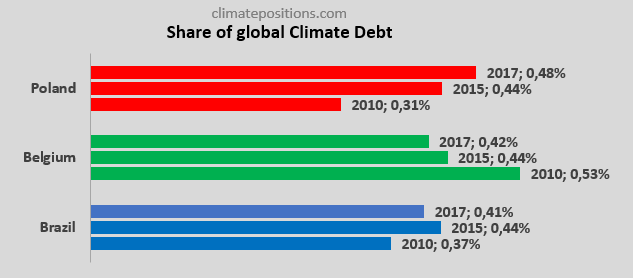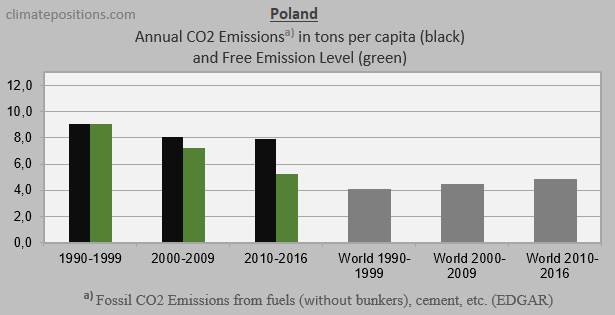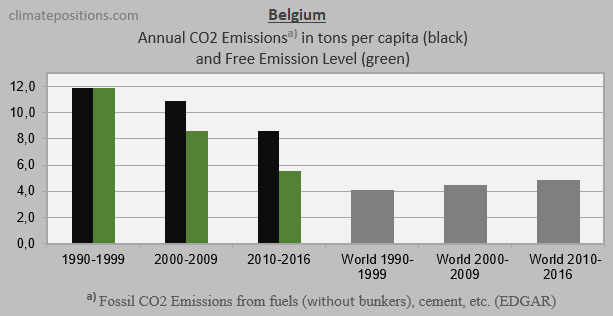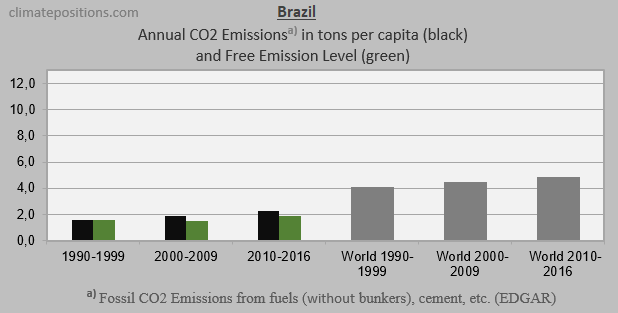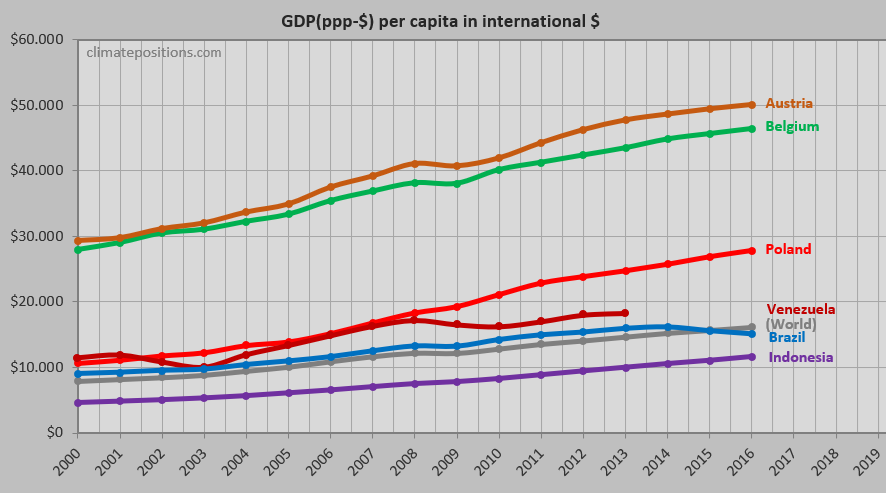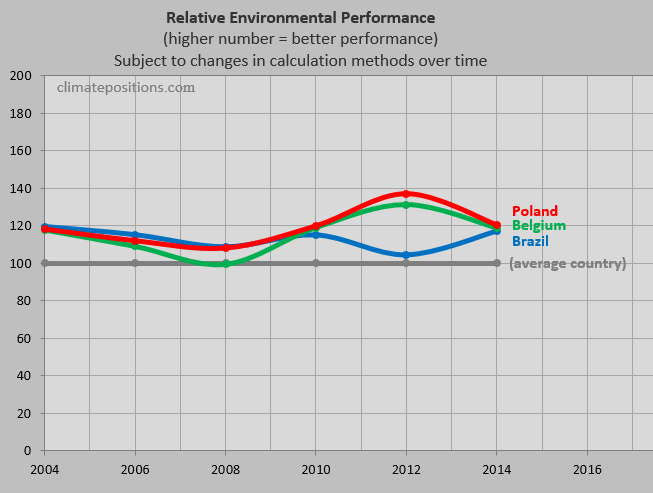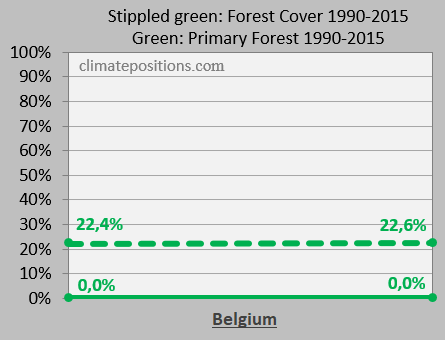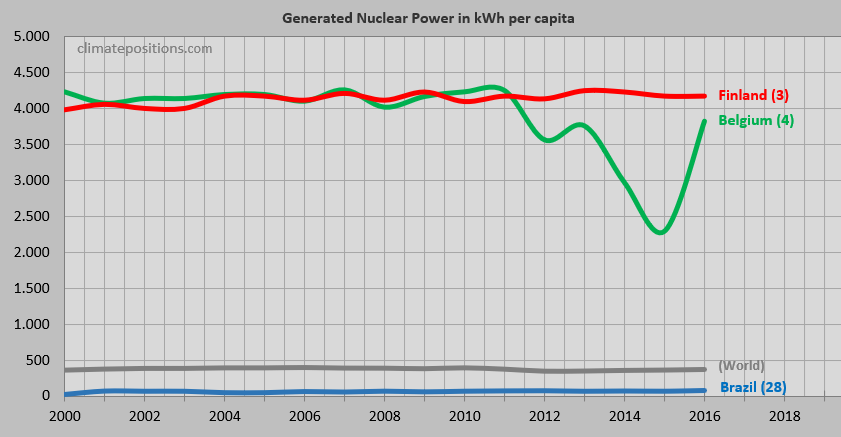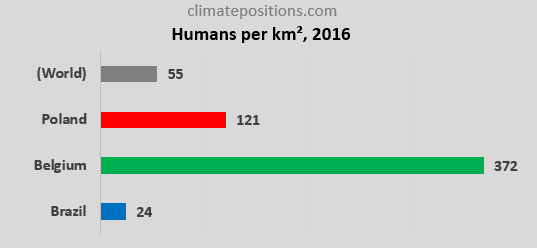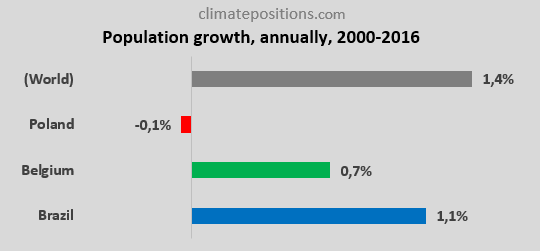Share of global Climate Debt rank 25th, 26th and 27th: Poland, Belgium and Brazil (combined responsible for 1.3% of Climate Debt and 2.4% of Fossil CO2 Emissions 2016)

2017
The diagram below shows ‘Share of global Climate Debt‘ in 2010, 2015 and 2017 of Poland, Belgium and Brazil (ranked 25th, 26th and 27th). By 2015, the shares of the three countries were similar. Since then, the Polish performance has declined, relatively.
The following exposes the key-data in the Climate Debt calculations: Fossil CO2 Emissions, GDP, Environmental Performance, Ecological Footprint without carbon, Forest Cover, Primary Forests, Nuclear Power, Population trends and climate change financing. For comparison, Austria, Indonesia and Venezuela (ranked 28th, 29th, and 30th in Share of global Climate Debt) are included in some diagrams.
The ‘Per capita Climate Debt‘ accumulated since 2000 of Poland, Belgium and Brazil are $912, $2,673 and $144, respectively. The second diagram shows the trends between 2010 and 2017, with world average set at 100, for the three countries as well as of Austria, Indonesia and Venezuela. The per capita Climate Debt ranking by October 2017 is shown in brackets.
The next three diagrams show Fossil CO2 Emissions from fuels and industrial processes¹, in tons per capita in decades, of Poland, Belgium and Brazil. The green bars show the Free Emission Level² – the exceedance is the basis for calculating the national Climate Debt. The grey bars are World emissions average.
CO2 Emissions data 1990-2016 (EDGAR) has been updated October 2017.
The three diagrams below show the per capita Fossil CO2 Emissions from fuels and industrial processes¹, annually since 2000, of the three countries. The green bars show the Free Emission Level². The reduction-rate of Belgium is insufficient, while Poland’s efforts looks plain pitiful. Brazil will be free of Climate Debt if emissions increases only by 29.4% by 2019, compared to baseline 1990s; which is probably too late.
The diagram below shows per capita GDP(ppp-$) of the six countries and the World average. The wealth of Belgium is 3 times greater than the one of Brazil (now below World average).
The next diagram shows the Relative Environmental Performance of Poland, Belgium and Brazil, with an average country set at 100. Currently, the three countries have comparable levels of performances. [Added 25-1-2018: See the new ‘Environmental Performance Index 2018‘]
The average per capita Ecological Footprint without carbon, between 2000 and 2013, with an average World country set at 100, of Poland, Belgium and Brazil are 126, 215 and 152, respectively. Release years are about four years after data years. Belgium’s Climate Debt would have been 10.8% smaller with World average footprint. Note that footprint calculation methods have changed over time. The latest and historic details from the source are available here: ‘Poland‘, ‘Belgium‘ and ‘Brazil‘.
Forest Cover and the precious Primary Forests as percentage of total land area, in 1990 and 2015, are important indicators in ClimatePositions. Poland and Belgium have nearly stable areas of Forest Cover and zero (or nearly zero) Primary Forests. Brazil’s large forests has decreased significantly since 1990, causing 42% of the Brazilian Climate Debt.
The per capita Nuclear Power generation 2000-2016 is shown below (the per capita ranking is shown in brackets). Belgium’s generation decreased in 2015, only to increase in 2016 (compared to Finland’s stable generation), while Brazil’s is nearly stably with a slight increase in 2016. In the calculation of Climate Debt, Nuclear Power must be phased out similar to Fossil Fuels, calculated as if Nuclear Power was oil-generated.
The diagrams below show Population density 2016 and growth between 2000 and 2016. The Population density in Belgium is almost 7 times higher than World average, and the Polish Population has decreased by 0.1% annually since 2000. The Populations of Poland, Belgium and Brazil are about 38, 11 and 208 million, respectively.
Finally, the table below shows four key values of Poland, Belgium, Brazil, Austria, Indonesia and Venezuela in the calculation of national Climate Debts in ClimatePositions. The price of CO2 per ton (column two) is for total CO2 Emission from Fossil Fuels (without bunkers) and industrial processes. Climate change financing (column three) is from July 2017.
| . | Tons of CO2 | Price per | Climate change | Financing as |
| . | exceeded since | ton CO2 | financing | share of |
| . | 2000, per capita | since 2000 | per capita | Climate Debt |
| . | . | . | . | . |
| Poland | 27.01 | $6.71 | $0.00 | 0.00% |
| Belgium | 44.42 | $15.92 | $27.05 | 1.01% |
| Brazil | 6.78 | $4.11 | $0.03 | 0.02% |
| Austria | 50.00 | $21.81 | $8.12 | 0.25% |
| Indonesia | 7.87 | $3.75 | $0.01 | 0.01% |
| Venezuela | 33.73 | $8.62 | $0.00 | 0.00% |
.
¹Fossil CO2 Emissions include all anthropogenic emissions from Fossil Fuel (combustion and production) and from industrial processes (cement, steel, liming, urea and ammonia production or consumption). The uncertainty in Fossil CO2 emissions is below 5% for industrialized countries and below 15% for developing countries. CO2 Emissions from international shipping and aviation (bunkers) are not included.
²The Free Emission Level (green bars) is determined by national CO2 Emissions 1990-1999 (base), and 11 more ‘Indicators‘, of which 7 are national and 4 are global.
.
Updated data and diagrams of all ‘Indicators‘ and all countries in ClimatePositions are available in the menu ‘Calculations (Excel)‘.
Data on Fossil CO2 Emissions (excluding international shipping and aviation) and industrial processes (cement, steel, liming, etc.) are from EDGAR (European Commission) (links in the menu Calculations / Sources & Links).
Information on national GDP(ppp-$) per capita: Worldbank (links in the menu Calculations / Sources & Links).
Source on Environmental Performance: Yale and Columbia University (links in the menu Calculations / Sources & Links).
Source on Ecological Footprint: Global Footprint Network (links in the menu Calculations / Sources & Links).
Data on national Forest Cover and Primary Forests are from United Nations UN (Report: Global Forest Resources Assessments) (links in the menu Calculations / Sources & Links).
Data on national Nuclear Power generation: World Nuclear Association (links in the menu Calculations / Sources & Links).
Data on national and global Populations is from Worldbank (links in the menu Calculations / Sources & Links).
PowerPoint collage with flags by Claus Andersen, 2017.
Comments are closed.
